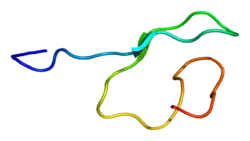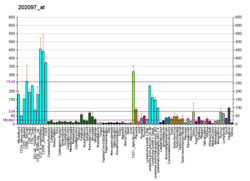Nucleoporin 153 (Nup153) is a protein which in humans is encoded by the NUP153 gene. It is an essential component of the basket of nuclear pore complexes (NPCs) in vertebrates, and is required for the anchoring of NPCs. It also acts as the docking site of an importing karyopherin. On the cytoplasmic side of the NPC, Nup358 fulfills an analogous role.
Background
Main article: Nuclear poreNuclear pore complexes are extremely elaborate structures that mediate the regulated movement of macromolecules between the nucleus and cytoplasm. These complexes are composed of at least 100 different polypeptide subunits, many of which belong to the nucleoporin family. Nucleoporins are pore complex-specific glycoproteins characterized by cytoplasmically oriented O-linked N-acetylglucosamine residues and numerous repeats of the pentapeptide sequence XFXFG.
Structure
Nucleoporin 153 has a mass of 153 kDA (hence its name). It is filamentous, and it contains three distinct domains: an N-terminal region within which a pore targeting domain has been identified, a central region containing multiple zinc finger motifs, and a C-terminal region containing multiple XFXFG repeats.
Interactions
NUP153 has been shown to interact with SENP2 and KPNB1.
References
- ^ GRCh38: Ensembl release 89: ENSG00000124789 – Ensembl, May 2017
- ^ GRCm38: Ensembl release 89: ENSMUSG00000021374 – Ensembl, May 2017
- "Human PubMed Reference:". National Center for Biotechnology Information, U.S. National Library of Medicine.
- "Mouse PubMed Reference:". National Center for Biotechnology Information, U.S. National Library of Medicine.
- Moroianu J, Blobel G, Radu A (1997). "RanGTP-mediated nuclear export of karyopherin alpha involves its interaction with the nucleoporin Nup153". Proc. Natl. Acad. Sci. U.S.A. 94 (18): 9699–704. Bibcode:1997PNAS...94.9699M. doi:10.1073/pnas.94.18.9699. PMC 23253. PMID 9275187.
- "Entrez Gene: NUP153 nucleoporin 153kDa".
- Hang, Jun; Dasso Mary (May 2002). "Association of the human SUMO-1 protease SENP2 with the nuclear pore". J. Biol. Chem. 277 (22): 19961–6. doi:10.1074/jbc.M201799200. ISSN 0021-9258. PMID 11896061.
- Zhang, Hong; Saitoh Hisato; Matunis Michael J (September 2002). "Enzymes of the SUMO modification pathway localize to filaments of the nuclear pore complex". Mol. Cell. Biol. 22 (18): 6498–508. doi:10.1128/MCB.22.18.6498-6508.2002. ISSN 0270-7306. PMC 135644. PMID 12192048.
- Nakielny, S; Shaikh S; Burke B; Dreyfuss G (April 1999). "Nup153 is an M9-containing mobile nucleoporin with a novel Ran-binding domain". EMBO J. 18 (7): 1982–95. doi:10.1093/emboj/18.7.1982. ISSN 0261-4189. PMC 1171283. PMID 10202161.
- Kehlenbach, R H; Gerace L (June 2000). "Phosphorylation of the nuclear transport machinery down-regulates nuclear protein import in vitro". J. Biol. Chem. 275 (23): 17848–56. doi:10.1074/jbc.M001455200. ISSN 0021-9258. PMID 10749866.
- Ben-Efraim, I; Gerace L (January 2001). "Gradient of increasing affinity of importin beta for nucleoporins along the pathway of nuclear import". J. Cell Biol. 152 (2): 411–7. doi:10.1083/jcb.152.2.411. ISSN 0021-9525. PMC 2199621. PMID 11266456.
Further reading
- Moroianu J (2000). "Nuclear import and export pathways". J. Cell. Biochem. Suppl 32-33 (S32): 76–83. doi:10.1002/(SICI)1097-4644(1999)75:32+<76::AID-JCB10>3.0.CO;2-Q. PMID 10629106. S2CID 45613755.
- Adam SA (2002). "The nuclear pore complex". Genome Biol. 2 (9): REVIEWS0007. doi:10.1186/gb-2001-2-9-reviews0007. PMC 138961. PMID 11574060.
- McMorrow I, Bastos R, Horton H, Burke B (1994). "Sequence analysis of a cDNA encoding a human nuclear pore complex protein, hnup153". Biochim. Biophys. Acta. 1217 (2): 219–23. doi:10.1016/0167-4781(94)90040-X. PMID 8110839.
- Yaseen NR, Blobel G (1997). "Cloning and characterization of human karyopherin beta3". Proc. Natl. Acad. Sci. U.S.A. 94 (9): 4451–6. Bibcode:1997PNAS...94.4451Y. doi:10.1073/pnas.94.9.4451. PMC 20743. PMID 9114010.
- Zolotukhin AS, Felber BK (1999). "Nucleoporins nup98 and nup214 participate in nuclear export of human immunodeficiency virus type 1 Rev". J. Virol. 73 (1): 120–7. doi:10.1128/JVI.73.1.120-127.1999. PMC 103815. PMID 9847314.
- Ullman KS, Shah S, Powers MA, Forbes DJ (1999). "The nucleoporin nup153 plays a critical role in multiple types of nuclear export". Mol. Biol. Cell. 10 (3): 649–64. doi:10.1091/mbc.10.3.649. PMC 25193. PMID 10069809.
- Nakielny S, Shaikh S, Burke B, Dreyfuss G (1999). "Nup153 is an M9-containing mobile nucleoporin with a novel Ran-binding domain". EMBO J. 18 (7): 1982–95. doi:10.1093/emboj/18.7.1982. PMC 1171283. PMID 10202161.
- Bachi A, Braun IC, Rodrigues JP, et al. (2000). "The C-terminal domain of TAP interacts with the nuclear pore complex and promotes export of specific CTE-bearing RNA substrates". RNA. 6 (1): 136–58. doi:10.1017/S1355838200991994. PMC 1369901. PMID 10668806.
- Kehlenbach RH, Gerace L (2000). "Phosphorylation of the nuclear transport machinery down-regulates nuclear protein import in vitro". J. Biol. Chem. 275 (23): 17848–56. doi:10.1074/jbc.M001455200. PMID 10749866.
- Kutay U, Hartmann E, Treichel N, et al. (2001). "Identification of two novel RanGTP-binding proteins belonging to the importin beta superfamily". J. Biol. Chem. 275 (51): 40163–8. doi:10.1074/jbc.M006242200. hdl:11858/00-001M-0000-0015-3D4E-B. PMID 11024021.
- Herold A, Suyama M, Rodrigues JP, et al. (2000). "TAP (NXF1) belongs to a multigene family of putative RNA export factors with a conserved modular architecture". Mol. Cell. Biol. 20 (23): 8996–9008. doi:10.1128/MCB.20.23.8996-9008.2000. PMC 86553. PMID 11073998.
- Hofmann W, Reichart B, Ewald A, et al. (2001). "Cofactor requirements for nuclear export of Rev response element (RRE)- and constitutive transport element (CTE)-containing retroviral RNAs. An unexpected role for actin". J. Cell Biol. 152 (5): 895–910. doi:10.1083/jcb.152.5.895. PMC 2198816. PMID 11238447.
- Ben-Efraim I, Gerace L (2001). "Gradient of increasing affinity of importin beta for nucleoporins along the pathway of nuclear import". J. Cell Biol. 152 (2): 411–7. doi:10.1083/jcb.152.2.411. PMC 2199621. PMID 11266456.
- Dimaano C, Ball JR, Prunuske AJ, Ullman KS (2002). "RNA association defines a functionally conserved domain in the nuclear pore protein Nup153". J. Biol. Chem. 276 (48): 45349–57. doi:10.1074/jbc.M102592200. PMID 11567018.
- Walther TC, Fornerod M, Pickersgill H, et al. (2001). "The nucleoporin Nup153 is required for nuclear pore basket formation, nuclear pore complex anchoring and import of a subset of nuclear proteins". EMBO J. 20 (20): 5703–14. doi:10.1093/emboj/20.20.5703. PMC 125666. PMID 11598013.
- Brownawell AM, Macara IG (2002). "Exportin-5, a novel karyopherin, mediates nuclear export of double-stranded RNA binding proteins". J. Cell Biol. 156 (1): 53–64. doi:10.1083/jcb.200110082. PMC 2173575. PMID 11777942.
- Hang J, Dasso M (2002). "Association of the human SUMO-1 protease SENP2 with the nuclear pore". J. Biol. Chem. 277 (22): 19961–6. doi:10.1074/jbc.M201799200. PMID 11896061.
| PDB gallery | |
|---|---|
| Autoantigens | |
|---|---|
| Dehydrogenase | |
| Transglutaminase | |
| Nucleoporins | |
| Other | |






